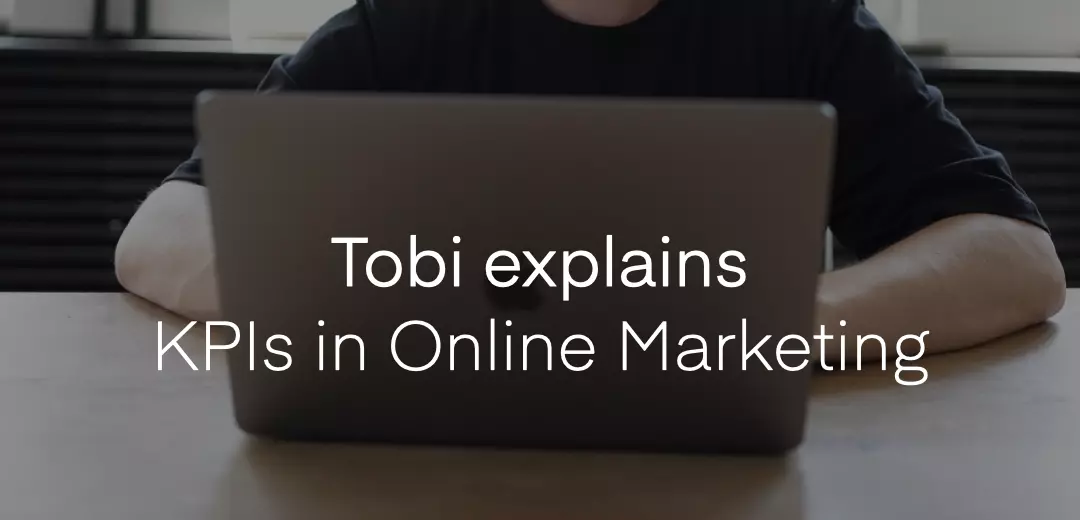Tobi explains -
KPIs in online marketing
After we dealt with the topic of web tracking in the last blog post "Tobi explains", today we are looking at another central aspect of online marketing: key performance indicators (KPIs). Find out what KPIs are, how to select the right KPIs and which important KPIs actually exist in online marketing.
You can find the video to accompany the blog post here:
What are KPIs in online marketing?
KPI stands for Key Performance Indicator. KPIs enable companies to monitor and analyze the success of their activities in various business areas, such as online marketing.
The KPIs can vary depending on which area of online marketing is being considered:
- Blogs: What is particularly important here is how long visitors stay on your site, i.e. the dwell time. The time a visitor spends on the page gives an indication of how appealing your content is.
- Sales-oriented websites: This is primarily about the number and quality of leads generated.
- Google Ads campaigns: Important KPIs here are the CTR (click through rate) and the cost CPC (cost per click). The ROAS (Return on Advertising Spend) shows you how profitable your advertising expenditure is.
How do you choose the right KPI?
There is a wide range of possible KPIs, so the challenge lies in making the right choice. Selecting meaningful KPIs requires a deep understanding of business and marketing objectives.
After all, if KPIs are not linked to a company's objectives, large amounts of time and money will be spent in vain to gather information that ultimately has no value in achieving the objectives.
The following points need to be considered:
- Goal definition: it must be clarified which goal is to be pursued. Example: The number of visitors from the organic search of an online store should increase by 30% within 6 months.
- Measurability: Consideration must be given to which data is relevant and how it can be measured. In the example, it would be important to know the exact number of visitors and to track how the ranking of the keywords changes.
- Reporting: Here you need to decide which tools and formats are best suited to monitor the KPIs and share them with others. In the example above, Google Analytics 4 could be used to collect visitor data and monitor the development. Continuous monitoring of KPIs makes it possible to adjust strategies in real time, recognize opportunities and identify potential problems at an early stage.
10 examples of important KPIs in online marketing
Below are some examples of key performance indicators that are relevant for online marketing:
- Conversion rate: A key measure of how many visitors* perform a desired action (e.g. purchase, registration) on a website or platform.
- Cost per click (CPC): The CPC shows what each click on an ad costs. It is particularly relevant for paid advertising campaigns such as Google Ads and is an important indicator of the profitability of these ads.
- Click Through Rate (CTR): The CTR indicates the percentage of users who click on a specific link of an ad in relation to the total number of users who have seen this ad. It shows how appealing and relevant an ad is to the audience.
- Return on investment (ROI): The profitability of a particular marketing activity measured by the profit generated in relation to the costs invested.
- Unique Visitors: This figure shows how many unique people have visited a website in a given period.
- Pages per visit: This shows how engaged visitors are and how many pages they have viewed on average per session.
- Dwell time: An indicator of how much time visitors spend on a page on average. A longer dwell time can indicate interesting and appealing content.
- Engagement rate (website): A measure of how interactive visitors* are with the content, i.e. users* who access at least a second page, trigger a specific event and stay on the website for longer than 10 seconds. It is therefore the ratio between interacting users and the total number of users of the website.
- Traffic Sources: This KPI provides information about the origin of visitors, divided into categories such as direct access, search engine access, paid access or referrals.
- Engagement rate (social media): This indicator shows how many users actually interact with the posts - for example in the form of likes, shares or comments - in relation to the followers. The engagement rate can therefore be more than 100%.
Of course, there are other KPIs. Depending on the specific objective and marketing channel, these can be just as relevant.
In summary, careful selection and analysis of KPIs is crucial. They not only allow companies to obtain valuable information about current performance, but also to identify potential areas for improvement in order to efficiently achieve the marketing objectives set.
To make sure you don't miss any of our blog posts and videos, you are welcome to follow us on our social media channels.
All posts in the "Tobi explains" knowledge format on the topics of SEO and web tracking can be found here:
- Tobi explains - SEO basics
- Tobi explains - OnPage and OffPage SEO
- Tobi explains - Technical SEO
- Tobi explains - Webtracking to measure success
